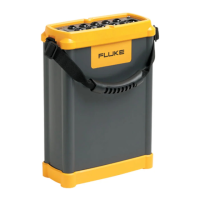7 Fluke Corporation Fluke 1750 Three-Phase Power Recorder
Transient voltage (impulse)
Measurement type
Waveshape sampling
Full scale
8000 V pk
Sample resolution
200 nS
Measurement uncertainty
± 5 % reading ± 20 V (test parameters: 1000 V dc, 1000 V rms, 100 kHz)
Dip (Sag) and Swell Measurements
Voltage swell (rms swell)
Measurement type
True rms (one cycle calculation by overlapping each half cycle - voltage between lines is measured
for 3P3W lines and phase voltage is measured for 3P4W lines)
Displayed data
Amplitude and duration of swell
Measurement uncertainty
Same as rms voltage
Voltage dip (rms sag)
Measurement type
True rms (one cycle calculation by overlapping each half cycle - voltage between lines is measured
for 3P3W lines and phase voltage is measured for 3P4W lines)
Displayed data
Amplitude and duration of dip or interruption
Measurement uncertainty
Same as rms voltage
Voltage dropout (interruption)
Measurement type
Same as voltage dip
Power Measurements
Calculated per IEEE1459 for best performance when distortion is present
Measurement type
True rms calculated continuously: every cycle, and every 10 or 12 cycles at 50 or 60 Hz respec-
tively, as required by standards
Measurement accuracy +/- (voltage uncertainty + current uncertainty + current probe uncertainty)
Frequency
Measurement range
42.5 to 69 Hz
Measurement source
Same as PLL synchronization source
Measurement accuracy
± 10 mHz (10 to 110 % of range, with sine wave)
Power factor
Measurement range
0.000 to 1.000
Measurement accuracy
± 1 digit from the calculation of each measured value (±3 digits for total)
Displacement power factor
Measurement method
Calculated from the phase difference between voltage fundamental and current fundamental
Measurement range
- 1.000 (leading) to + 1.000 (lagging)
Measurement accuracy
± 0.5 % reading ± 2 % full scale ± 1 digit
Voltage unbalance and phase sequence
Measurement method
Positive sequence voltage divided by negative sequence voltage, per IEC 61000-4-30
Harmonic voltage and current
Analysis window
rectangular
Analysis order
1st to 50th order
Measurement accuracy
Voltage / Current: 1st to 20th orders: ± 0.5 % reading ± 0.2 % full scale, 21st to 50th orders: ± 1 %
reading ± 0.3 % full scale (current sensor accuracy must be included for current and power)
Measurement method
IEC 61000-4-7
Inter-harmonic voltage and current (intermediate harmonics)
Analysis window
rectangular
Analysis orders
1.5 to 49.5th order
Measurement method
IEC 61000-4-7
Voltage flicker
Measurement method
as per EN 61000-4-15:2003: 10 min (Pst), 2 h (Plt)

